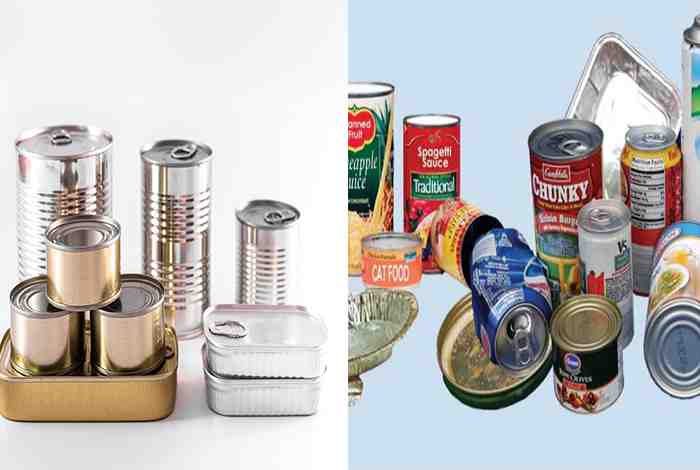Are cat food cans recyclable? Yes, they can be recycled. The cat food cans are recyclable because their aluminum and steel can be recycled into new products.
The paper liners inside the cans can also be composted for reuse or reused as paper towels at home or work. Allowing the cat food cans to be recycled is good for our environment, too!
Different recycling companies in many countries carefully plan the process of recycling. The waste is collected and sorted by the recycling company. Machines in the recycling plant do the sorting. Then, the paper is separated from other waste types and recycled into new paper.
The plastic bottles are cleaned, washed, and turned into plastic for other products. And glass bottles are crushed so they can be turned into new glass products or made into a sand-like substance to make concrete.
Proper placement of cans [and papers] during the collection at home and separate collection are necessary for effective recycling.
Some cans are recyclable, but most are not. This article will explore what happens to a can after it is empty and how recycling cat food tin cans can affect the environment.
Empty cat food cans can be recycled, but they still have some things to dispose of. Take them directly to a local recycling center to recycle the empty cans. Many people put cat food cans in a blue recycling bin. These bins are located outside businesses and homes and can be found near curbs and other collection points.
Table of Contents
Are cat food cans recyclable?
The recycling of cat food cans begins at the factory when they are made. An aluminum and steel alloy is mixed within the cans to make them sturdy, leak-proof, and lightweight. This material can be recycled.
In addition, plastic bottles are placed inside the cans to keep vitamins and nutrients flowing through the cat’s system. [Cat food] can liners must be removed before recycling or put on top for recycling, though most people will throw them away and go about their business as if they were garbage.

Cat food cans are also hygienic because the inside of the cans is lined with a paper product. This is free from bacteria and other germs, making cat food durable when it’s not used.
Because of its protective coating, cat food is often the last to be recycled. The liners must be removed first, but many people will throw them away without recycling them or discarding them properly.
A three-step process for recycling cat food cans [and papers]
First, the paper lining of the cans is separated from other debris in the waste stream. Then, squeezing the empty cans removes any remaining vegetable oil and vitamin powder (if made of vitamin powder). Finally, they are shredded and melted down by a machine to create new products.
Recycling at home
If the liners are included in recycling, ensure they are properly placed, so they do not get mixed in with other garbage from homes or businesses. Otherwise, they can ruin the entire batch of recycled materials.
Once the paper liners are removed, they can be composted or put in the recycling bin to be turned into new paper products.
Ways to recycle cat food cans at home
1. Recycle at home or work by separating cat food cans from other recyclables. This means that clean cat food cans should not be placed in a blue recycling bin with other recyclable items such as glass and plastic bottles.
2. Put empty cat food cans in the trash to be disposed of properly.
3. Recycle empty cat food cans at a local recycling center or home if you have a place to put them where they will not cause a mess.
How to Clean Cat Food Cans for Recycling?
1. Wash out the cans using clean water to get all the food and dust from the cans.
2. Put them in a clean space where they will get rinsed off again.
Properly dispose of food and pet waste in a trash can or large trash bag for easy disposal, and keep it away from living areas or trees where birds could be attracted to your litter.
3. Clean up all wood pieces in the area where you have already removed the cans for recycling.
4. Wash the area once more to remove any remaining food or waste material.
5. Rinse cat food cans under rerunning water and let them dry before putting them back for recycling. Please place them in a clean, dry place to preserve their integrity for recycling.
6. Get rid of any food scraps or leftover liquids from the cans.
7. Let them dry again before placing the cans to be recycled.
8. After all of the cans are washed out, place them on a clean table or other areas where they will not be disturbed by pets or wildlife.
What to do with empty cat food cans?
Handle the empty cans with care to avoid breaking them.
1. Take empty and cleaned-out cans to a recycling center.
2. Put the emptied and dried cans back in a clean, dry place where they will not be disturbed by pets or wildlife.
3. Remove any remaining food or liquid from the can so their integrity is preserved for recycling, but do not throw the food or liquid away with other garbage trash in your trash can.
4. Wash out the cans once more to remove any remaining food residue.
5. Let them dry before placing them in a clean, dry place to preserve their integrity for recycling.
6. Remove the cat food cans from your trash can so they will not be mixed up with other garbage in your trash can.
7. Read the instructions on the packaging that came with the cans so you will know what to do after use and how to clean them properly for recycling.
Can you recycle food cans for money?
Yes, you can make money by recycling food cans. If you find empty and clean cat food cans, it is better to take the empty cans to a business that deals with the recycling of empty and clean containers.
Many people will try to sell off the empty and clean cans. Some people have technicians that can remove the plastic and paper wrappings. They will also remove the aluminum and steel in the cans to ensure they are properly recycled. You can sell these products to a recycling company, so you will make money when selling them at a recycling center.
Are cat food cans recyclable in California?
Most people in California can recycle cat food cans. Though there are some communities where they cannot recycle the cans, it is not a big issue because the state of California is behind most other states in the country when it comes to recycling empty and clean cat food cans.
These containers cannot be recycled in some areas because of their size and weight. There are recycling centers near you where these products are shredded or melted down to make new products.
Are cat food cans recyclable for money?
You can make money by recycling cat food cans. If you find empty and cleaned out cans, it is better to take the empty and cleaned out cans to a business that deals with the recycling of empty and clean containers.
You can sell the cat food cans. Though some people will try to sell off the empty and cleansed containers, some have technicians who can remove the plastic and paper wrappings. They will also take out the aluminum in these products so that they are not broken or damaged when recycled.
Is There a Difference Between Aluminum and Steel Cans?
Yes, steel and aluminum cans are different. Steel cans are heavier than aluminum cans because they contain much more metal. They will often be marked as steel cans because of their weight.
Aluminum cans contain less metal, so they do not weigh as heavily as steel cans. They will often be marked as aluminum cans because of their lighter weight.
How many aluminum food cans are in a pound?
The number of aluminum food cans in a pound will vary according to the size and weight of each can. A 1-pound aluminum can usually weighs between 8 and 9 ounces and contains 30 to 34 empty cans. The more cans the pound has, the greater the weight, and the greater the weight, the more money you will make when you sell them.
Are Cat Food Can Lids Recyclable?
There are some recycling centers in California where the cat food can lids are not recyclable. They are not recyclable because they cannot be disassembled at each recycling center.
If your recycling center allows you to separate the lid from the container, you will be able to recycle them. However, if your recycling center does not allow you to separate the lids from the cans and containers, you will not be able to recycle them for any money.
What are fancy feast cans made of?
Fancy feast cans are made of aluminum, an excellent metal that is easy to recycle and allows anyone who recycles them money while they are doing the environment some good too.
What Are Tin Cans Made Of?
There are a number of different materials that make up a tin can, or you could say there is more than one type of tin can.
You will find tin cans made from aluminum and stainless steel that often have paper labels or plastic wrappings around them.
Are Sheba cat food containers recyclable?
Yes, Sheba cat food containers are recyclable for only a small amount of money.
Most commercial recycling centers will not accept them because they are fairly heavy and require additional sorting. If you find a Sheba, ensure it is disassembled and inspected by the recycling center employees before taking it to them.
I am storing empty cans in my refrigerator to keep from having to throw them away when they get too old.
Conclusion
If you want to keep your cans out of the garbage, you must use them before they get too old. They will last a long time and are safe for your family.
If you have an empty and clean can, then recycle them immediately. If you sell them at a recycling center, empty and clean cans are recyclable for money.
I hope this information has helped you to learn more about recycling cat food cans. If you want, please leave your thoughts in the comment section and let us know how this article has affected you.

Hi there! My name is Koushik; I am a cat lover. I specialize in writing about pet care & food. I have a wealth of knowledge on cat food niches and related subjects. I have worked in the pet industry for over 5 years and am passionate about helping cat owners provide the best care for their furry friends. With knowledge of cat food and nutrition, I aim to share their insights and help cat owners navigate the world of cat food niches. I enjoy playing with my two cats, reading, and exploring new cat food brands in my free time.